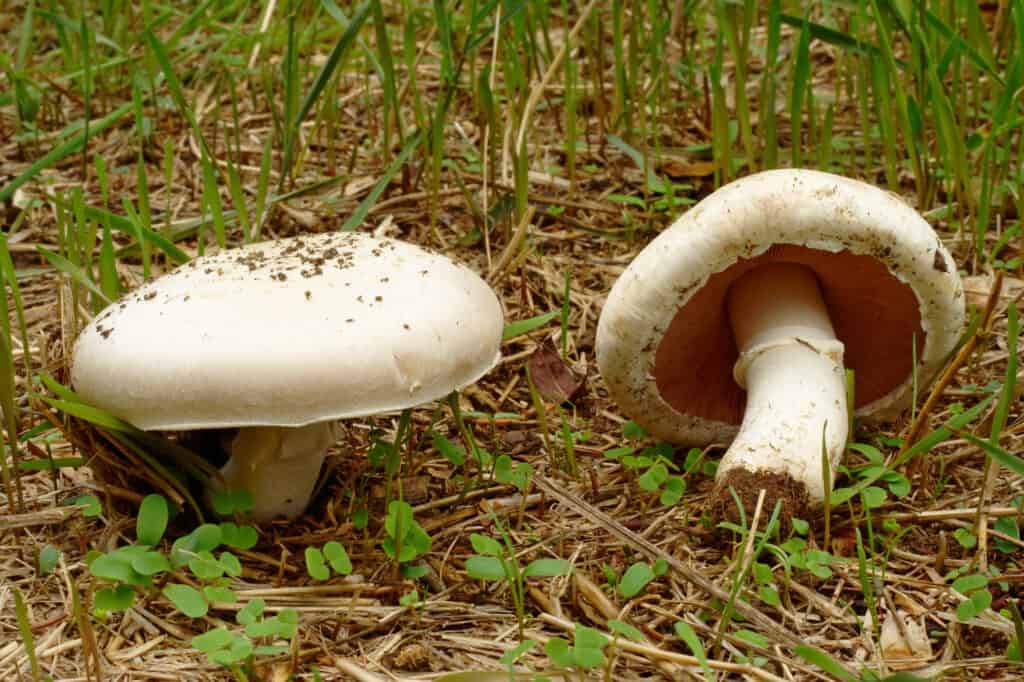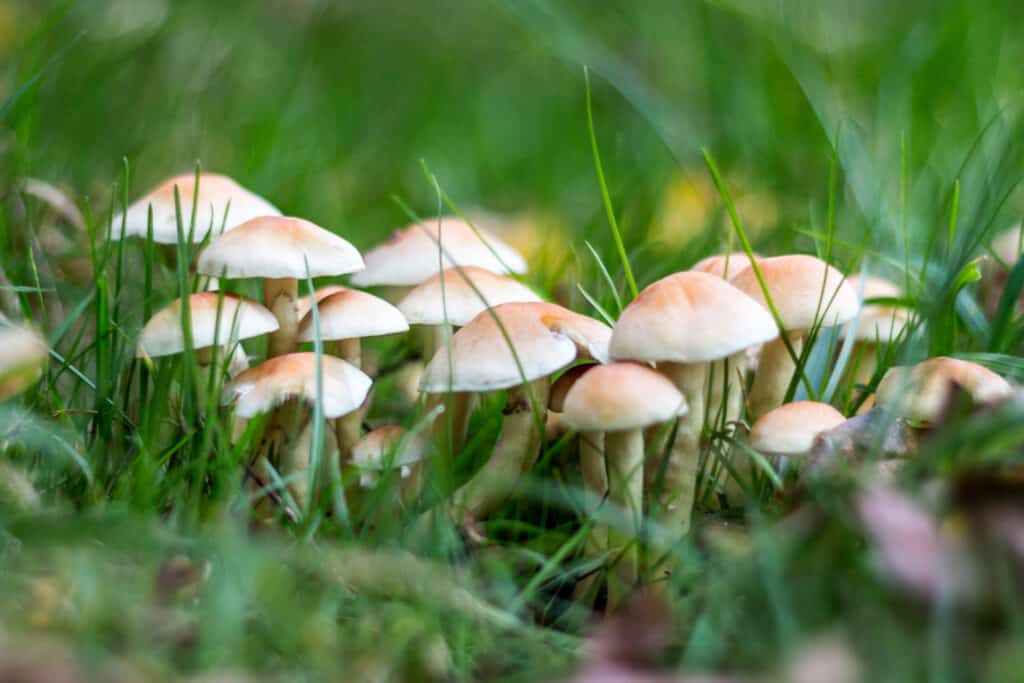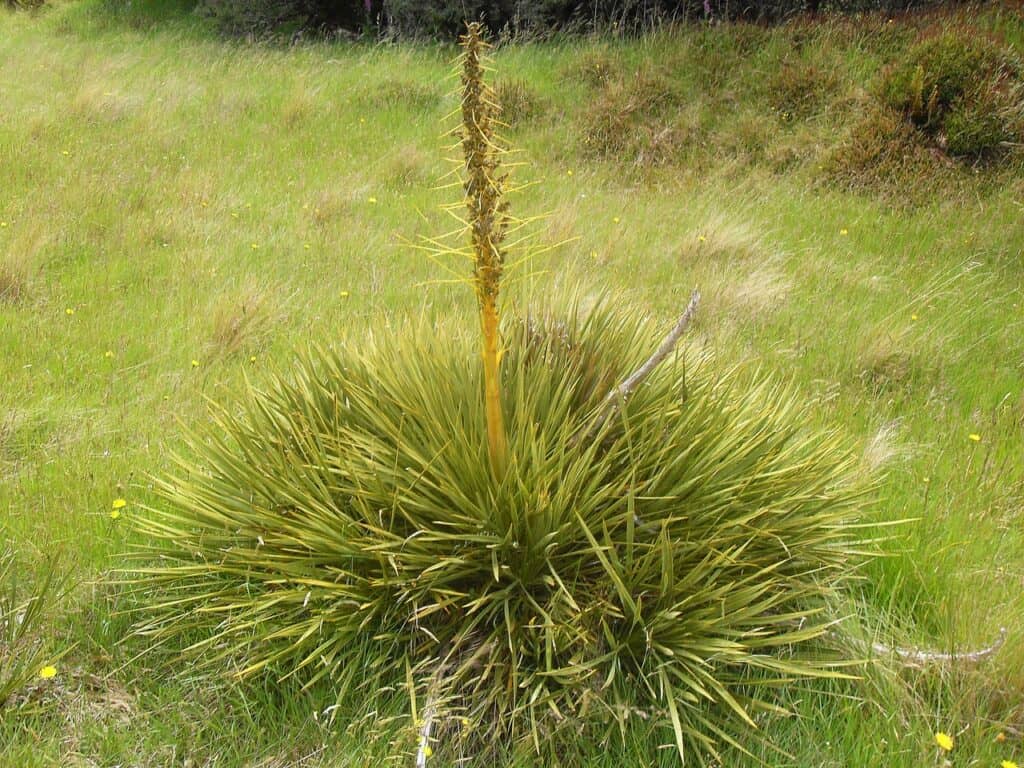Looking out across your lawn this morning, you may have awakened to the sight of mushrooms growing among your grass, garden, and trees. However, despite growing together and seemingly living the same lives, mushrooms and other types of fungi aren’t the same as plants. In fact, they’re not even in the same kingdom, much less family!
So, are mushrooms and other fungi considered plants? Keep reading to find out the detailed answer and more!
Plants vs. Fungi: Taxonomy
There are both many differences and similarities between plants and fungi. However, for plants and mushrooms, as well as any other organism in the world, the best way to learn if two species are related and how they’re related is to take a look at their lineage. This involves tracing their evolutionary line back to common ancestors. The best way to begin this process? Take a look at taxonomy.

Mushrooms and plants have separate taxonomies.
©iStock.com/fedsax
What Is Taxonomy?
When you’re trying to figure out whether or not mushrooms and fungi are types of plants, it’s important to look toward taxonomy.
Humans have always cared for organization. Research has shown even our ancestors, the Neanderthals, cared about better understanding where things belong – as seen from the remains of their tidy shelters that researchers have managed to uncover. And, when it comes to our love of classification, the organisms of the world aren’t an exception.
Taxonomy is a branch of science that focuses on organizing all of the organisms found on Earth. From plants to animals to even fungi, taxonomy is a study of systematics that helps us better understand how one creature is related to another. Taxonomy is also where you will see scientific names. For instance, the scientific name for humans is Homo sapiens. This includes the genus and the species (or epithet) name, but it can go much further to include other important branches, such as kingdom and family.
Overall, there are eight different classifications in taxonomy. These include domain, kingdom, phylum, class, order, family, genus, and species. When you’re trying to tell if two organisms are the same or even related, it’s important to have a good understanding of their classifications. Because each level of classification is known to have certain characteristics, it can help you to better identify similarities or differences. As a result, it can be great when you’re trying to learn whether or not mushrooms and fungi are plants!
Taxonomy and Kingdoms
When you’re trying to tell whether or not two organisms are related, you’ll want to start with the more diverse level of classification and work your way down. Typically, this will begin with domains. There are three overall domains of life: the Archaea, the Bacteria, and the Eukarya. Unless you’re working with bacteria and microorganisms, you’ll usually focus on the Eukarya.
As a result, when we’re focusing on things like humans or plants or other animals, telling who is who usually comes down to the kingdom. There are four different kingdoms in the domain Eukarya: Fungi, Plantae, Animalia, and the less-known Protista.
From these four kingdoms, there are hundreds of possibilities. Each one is its own separate branch, developing a hugely diverse tree of life.
When it comes to telling whether or not mushrooms and other fungi are plants, it’s best to look at the taxonomy. This helps us to see where scientists have placed them over the years after studying their characteristics and similarities — or differences.
Plants are in the kingdom Plantae. They are divided into seven different Phyla:
- Bryophyta (Mosses)
- Hepatophyta (Liverworts)
- Anthocerotophyta (Hornworts)
- Equisetophyta (Horsetails)
- Pteridophyta (Ferns)
- Coniferophyta (Conifers)
- Ginkgophyta (Ginkgo)
However, mushrooms and fungi don’t fit into any of these categories. Instead, they have their own kingdom. Mushrooms, as well as other types of fungi, are found in the kingdom Fungi. Therefore, mushrooms and fungi are not classified as plants.
Plants vs. Fungi: Nutrition
There are more than systematics and taxonomy dividing mushrooms and fungi from plants.
One of the major differences between fungi and plants is how they acquire their energy. Most plants undergo a process that is known as photosynthesis. During photosynthesis, plants utilize sunlight and carbon dioxide to produce a sugar known as glucose, as well as oxygen. The plants are then able to break down the sugar they’ve created to use as fuel. Because they are creating their own energy, they are what is known as an autotroph.
Mushrooms, however, are actually like humans and other animals! They are what is known as a heterotroph. This means that they are unable to create their own food through a process like photosynthesis. Instead, most mushrooms grow near decaying material, such as fallen logs, in order to break down the nutrients available there. Some types of fungi, such as mycorrhizal fungi, receive their nutrients in a different way! However, even these types of fungi don’t engage in photosynthesis in the way plants do. They have mutualistic bonds with different types of plants where they share nutrients.

Mushrooms cannot create their food using photosynthesis.
©iStock.com/Dan Fog Madsen
Plants vs. Fungi: Motion
Just because they’re in different kingdoms and have different characteristics, this isn’t to say that there are no similarities between plants and mushrooms. In fact, they have a lot in common, which is one reason why it can be tempting to call mushrooms and fungi plants.
Both plants and mushrooms lack locomotion. This means that they can move, such as bending towards the sunlight or growing taller, but they are unable to move to a new location through means like walking.
They also have a lot in common on a cellular level!

Plants and mushrooms can both react to sunlight.
©Andre Chalmers / CC BY-SA 3.0 – License
Plants vs. Fungi: Cells
All living things, whether it’s a plant or an animal, has cells. Some organisms only have one cell, while others are multi-cellular. As you learned further above, plants and fungi fall into the latter category. Even though plants and fungi are in different kingdoms, you’ll find that there are some similarities between their cells.
One of the most notable examples of this is the fact that both plant and fungi cells have what is known as a cell wall. The cell wall is a strong sugar barrier that surrounds the cell’s perimeter. Animal cells lack this cell wall. However, while both cell types have this wall, they aren’t made the same when it comes to plants and fungi. Plant cell walls are made up of glucose, while fungi cell walls are made of chitin. There are other materials that help form the cell wall, as well, but these two components are the main differences.
Plant and fungi cells also have membrane-bound nuclei. The nucleus is like the brain of the cell. It is where all genetic information is stored. In single-celled organisms, there is no membrane available to protect the nucleus.
The photo featured at the top of this post is © iStock.com/Dan Fog Madsen
The information presented on or through the Website is made available solely for general informational purposes. We do not warrant the accuracy, completeness, or usefulness of this information. Any reliance you place on such information is strictly at your own risk. We disclaim all liability and responsibility arising from any reliance placed on such materials by you or any other visitor to the Website, or by anyone who may be informed of any of its contents. None of the statements or claims on the Website should be taken as medical advice, health advice, or as confirmation that a plant, fungus, or other item is safe for consumption or will provide any health benefits. Anyone considering the health benefits of particular plant, fungus, or other item should first consult with a doctor or other medical professional. The statements made within this Website have not been evaluated by the Food and Drug Administration. These statements are not intended to diagnose, treat, cure or prevent any disease.
Sources
- Livescience (1970) livescience.com/41682-neanderthals-organized-their-caves.html
- National Library of Medicine, Available here: https://www.ncbi.nlm.nih.gov/taxonomy
Thank you for reading! Have some feedback for us? Contact the AZ Animals editorial team.






